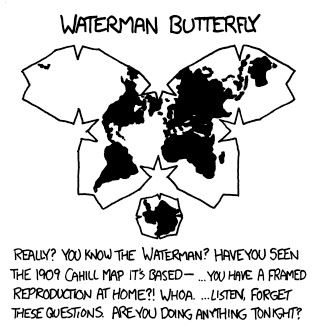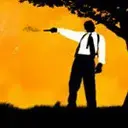https://en.wikipedia.org/wiki/Flag_of_California

The Bear Flag is the official flag of the U.S. state of California.[2] The precursor of the flag was first flown during the 1846 Bear Flag Revolt and was also known as the Bear Flag.
The 1911 statute stated:
The bear flag is hereby selected and adopted as the state flag of California. … The said bear flag shall consist of a flag of a length equal to one and one-half the width thereof; the upper five-sixths of the width thereof to be a white field, and the lower sixth of the width thereof to be a red stripe; there shall appear in the white field in the upper left-hand corner a single red star, and at the bottom of the white field the words ‘California Republic,’ and in the center of the white field a California grizzly bear upon a grass plat, in the position of walking toward the left of the said field; said bear shall be dark brown in color and in length, equal to one-third of the length of said flag.
https://en.wikipedia.org/wiki/California_grizzly_bear
Grizzly bear meat became a mainstay on restaurant menus in the San Gabriel area; according to Mike Davis, “The paws from adult bears and the flesh from young cubs were deemed particular delicacies.”[39]
In 1866, a grizzly bear described as weighing as much as 2,200 pounds (1,000 kg) was killed in what is present-day Valley Center, California, in the north-central area of San Diego County. The incident was recalled in 1932 by Catherine E. Lovett Smith, who witnessed the bear’s killing on her family’s ranch when she was just six years old. If its measurements are accurate, this particular bear was the biggest bear ever found in California and one of the largest specimens of any bear species ever recorded.
Extinction
The last hunted California grizzly bear was shot in Tulare County, California, in August 1922, although no body, skeleton or pelt was ever produced. Less than 75 years after the discovery of gold in 1848, almost every grizzly bear in California had been tracked down and killed. In 1924, what was thought to be a grizzly was spotted in Sequoia National Park for the last time and thereafter, grizzlies were never seen again in California.
Apex predators tended not to have evolved the instinct to hide, which served them poorly when Earth’s superpredator decided that they were delicious.
why does the flag only have 1 head?
Context: For those not familiar, the Fallout video game series has a spoofed version of the California state flag:

Truth is, the game was rigged from the start
Also dropped out the New part from the text
Like the Cedars of Lebanon, long, long since logged out of existence.
What part of history. Pre Western expansion, pre contact, or pre Holocene.
Early 1900s
Ah yes, good thing the California deserts are all shaded in. This is a great map.
So sad the Death Valley Grizzlies didn’t make it.
Why did they historically not go further east?
They did, at least into Minnesota. This range map probably doesn’t use data from as long ago as when they did.
I was definitely thinking the time (and method) of this data collection. It kind of appears to reflect US western expansion.
Pure guess, but the praries are probably not a good habitat for them. Hard for them to hunt, and the buffalos could easily mess them up.
Yeah trees and mountains make sense. Like the Sierra range in California / Nevada. Or the Rockies. But that map shows way down into Mexico where I imagine it is pretty flat and trees are not as dense (which i guess is kind of similar to a prairie?) Interesting point on the buffalo, i can see that.
In Mexico? Specifically Baja California? With that much fur??
It wasn’t so arid in the Pleistocene but a pine forest(https://www.sciencedirect.com/science/article/abs/pii/S0033589401922872). That’s back when the glaciers were still around and height of hominid impact was small hunter gatherer groups with some sharp rocks at best.
There was a recent Baja grizzly up to the 1800s but this map is hard to interpret on time period because the population goes very far south and east into the great plains. It’s likely pre westward expansion, but without being explicit it’s hard to tell.
I’ve definitely seen more than one grizzly in that finger of green in South Central BC…
Yeah, this map is wrong. There are a handful of grizzlies in the Northern Cascades.
Hunters and hikers in northern WA are still advised to be aware they are rare, but still a possible encounter, in the Cascade foothills.
But yeah, they are certainly a lot more rare than they used to be.
Holy whit what a read. The political pressure and bureaucratic nightmare of this all is really jarring.
Partial contradiction:
Brown-bear fossils discovered in Ontario, Ohio, Kentucky, and Labrador show that the species occurred farther east than indicated in historic records.
While grizzly bears are brown bears. Not all brown bears are grizzlies.
Sure but “grizzly” is the vernacular name for “North American brown bear”, so that’s not pertinent to the map or my comment.
Is there any overlap with current and historical ranges?
Exactly. Is this map showing us that theyre moving north/west or is it showing us the area is shrinking. I cant really draw any conclusions
Good question. I assume that all of current falls under historic, but that could not be the case.
What. I thought they were supposed to be the jewel of american culture. I didn’t know they were basically extinct from the lower 48.
Historically, if you weren’t talking about the bald eagle, the US tended to be symbolized by the bison (which we in the US call the "buffalo). It got pretty clobbered too, though.
They are more a jewel of Californian culture. I’ve never seen them associated with all of America.
Good on America for winning the war against grizzly bears.
Oh, we can’t take all the credit.
https://en.wikipedia.org/wiki/Eurasian_brown_bear
Brown bears could once be found across most of Eurasia, compared to the more limited range today. General habitats included areas such as grassland, sparsely vegetated land, and wetlands.
Although included as of Least Concern on the 2006 IUCN Red List of Threatened Species (which refers to the global species, not to the Eurasian brown bear specifically), local populations, specifically those in the European Union, are becoming increasingly scarce.[16] As the IUCN itself adds: “Least Concern does not always mean that species are not at risk. There are declining species that are evaluated as Least Concern.”
The brown bear has long been extinct in Britain (at least 1,500 years ago, possibly even 3,000 years ago),[17][18] Denmark (about 6,500 years ago),[19] the Netherlands (about 1,000 years ago, although later singles rarely wandered from Germany),[20] Belgium and Luxembourg, with more recent extinctions in Germany (in the year 1835, although singles wandering from Italy were recorded in 2006 and 2019),[21][22] Switzerland (in 1904, although a single was seen in 1923 and since 2005 there has been an increasing number of sightings of wanderers from Italy),[23][24] and Portugal (in 1843, although a wanderer from Spain was recorded in 2019).[25]
The largest brown bear population in Europe is in Russia, where it has now recovered from an all-time low caused by intensive hunting.
You know what, I’m just going to say it … I’m glad they don’t occupy that same range any longer. Grizzly bears are terrifying and I like being in nature.
I know it seems scary, but their existence has little to no impact on outdoor recreation. They don’t want to be around us anymore than we want to be around them.
All the times I’ve run into a grizzly hiking or backpacking, they either ignore me or leave. Conflicts are rare, and almost exclusively happen because of a surprise close encounter, or someone comes too close to a carcass a bear is camping out on.
The ones to worry about are the damn cow elk during calving season. Pure chaotic evils.
Source: I’m from the grizzly range of western Montana and lived in Yellowstone National Park for many years.
You like being in a sanitised artificial nature. It’s like someone who likes castles hanging out at Disneyland.
I live in a place without grizzly bears, must be Disneyland
This list is probably not a complete accounting of all incidents, but it dates back to the 1780s, and has 88 cases where a brown bear killed a human.
https://en.wikipedia.org/wiki/List_of_fatal_bear_attacks_in_North_America
Going the other direction:
https://www.fws.gov/species/grizzly-bear-ursus-arctos-horribilis
Prior to 1800, an estimated 50,000 grizzly bears were distributed in one large contiguous area throughout all or portions of 18 western States, including Washington, Oregon, California, Idaho, Montana, Wyoming, Nevada, Colorado, Utah, New Mexico, Arizona, North Dakota, South Dakota, Minnesota, Nebraska, Kansas, Oklahoma and Texas.
Grizzly bears were reduced to close to 2% of their former range in the 48 contiguous states by the 1930s, with a corresponding decrease in population, approximately 125 years after first contact with European settlers.
The kill-to-death ratio is pretty favorable to humans.
Wow, The “lower 48” barely has them. They’re just kind of normal animals in western Canada.
“Alright, I’ll go to Dallas or Monterey, but dammit I’m not fucking going to Houston, St. Louis, or Guadalajara!”
Read “ranges” as “wages” and was tremendously confused for a minute…








